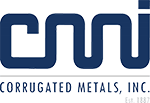The concept of roll forming dates back as far as 600 BC. The machinery and technology used today were of course not around at this time. However, the process of learning how to fabricate different types of metal and form them into useful shapes was created.
Today, custom roll forming is a highly efficient and cost-effective method for the construction industry. From roofing and siding to structural components and trim, custom roll forming can help builders and contractors discover new opportunities for their construction projects and stay ahead of the competition.
In this blog post, we will explore the various applications and benefits of custom roll forming in the construction industry.
Common Applications
The process of custom roll forming enables the creation of complex shapes and sizes that are not easily achievable with traditional manufacturing methods. Some common application examples include:
- Window and door frames: As an important component of any building, custom roll forming creates frames that are lightweight, durable, and easy to install. This is particularly important in high-rise buildings where the weight of the frames can become a significant concern. Custom roll forming can also be used to create frames that are made from high-strength materials, such as aluminum or steel, which are able to withstand high wind loads and provide enhanced security.
- Roof and cladding panels: When it comes to roofing and cladding panels, custom roll forming is used to fabricate panels with unique profiles and shapes. These components can add interesting and visually appealing designs to any building as well as practical elements that can increase the lifespan of the roof and reduce the cost of maintenance.
- Architectural components: Such as cornices, fascias, and decorative trims, these components are often used to enhance the aesthetics of a building and can be created in a range of shapes and sizes using custom roll forming. This gives architects and designers more creative freedom to bring to life unique and interesting designs that would be difficult or impossible to achieve using traditional manufacturing methods.
Biggest Benefits
It’s clear that custom roll forming is used to support a variety of use cases. But why is this technique becoming increasingly popular in the construction industry compared to traditional manufacturing processes? Let’s take a closer look at the biggest advantages:
- Increased efficiency and cost-effectiveness: Traditional manufacturing methods often require several stages of processing, which can result in longer lead times and increased costs. Custom roll forming, on the other hand, is a continuous process that can create components in a single pass, resulting in faster turnaround times and reduced costs. In addition, custom roll forming creates components that are more lightweight than traditional components, which can reduce shipping and installation costs.
- Reduced material waste: To create a desired shape using traditional techniques, manufacturers must cut excess material from large sheets prior to cutting the precise shape, which can result in a significant amount of wasted material. With custom roll forming, skilled manufacturers (like CMI) can simply shape the material as it is being fed through the machine, reducing the amount of material wasted and also lowering material costs. (Click here for more ideas on how to reduce waste in construction!)
- Design flexibility: The custom roll forming process enables the creation of complex shapes and sizes in a wide range of materials (including steel, aluminum, and copper), which provides architects and designers with more options for their building components. For example, by using custom roll forming, architects can incorporate intricate shapes, curves, and angles to create components that fit seamlessly into the overall design of the building. Not only do these components contribute to the building’s aesthetic appeal, but they also serve specific functional requirements such as ventilation systems, drainage systems, and other specialized purposes.
- Consistent and precise components: Custom roll forming creates high-quality and precise profiles with tight tolerances. The process is computer-controlled, which means that components are created with a high level of accuracy and consistency. This can result in components that fit together seamlessly during installation, which can reduce installation time and costs. Additionally, the use of custom roll forming can eliminate the need for additional machining or processing after the element is created, which can further reduce costs and lead times.
As you can see, custom roll forming is a game changer when it comes to manufacturing processes. These benefits combined with the constant evolution of new roll forming technology make it an immensely valuable solution for the construction industry.
Example of Custom Roll Forming
Custom roll forming has been used successfully in many construction industry projects. For example, as a company that specializes in corrugated metal roofing and siding solutions, CMI used custom roll forming to create a unique profile for Denver, Colorado’s Convention Center – which eventually became an architectural landmark in the city.

Using precision and artistry, we created the undulating waves of metal attached to the building’s facade, providing a contemporary and distinct look. The sleek, modern design began with the fabrication of corrugated stainless steel panels, which were perforated to create a dramatic blend of light and shadow. Each panel was formed with uniform curvatures, aligned precisely when installed on the building exterior, and polished to a brushed finish.
The corrugated and perforated panels provided a simple yet elegant solution, creating a striking design that added both depth and texture to the building’s exterior. And, since roll forming adds both strength and rigidity to materials, this configuration helped lower costs by enabling the use of lighter-weight materials to achieve the same performance properties as heavier gauge sheet metal.
Getting Started
Custom roll forming has come a long way in recent years. The latest advancements in technology have led to the development of new materials, such as high-strength steel and aluminum alloys, which are lighter and more durable than traditional materials. These improvements have made custom roll forming an increasingly attractive option for companies in the construction industry.
At CMI, we have over 100 years of experience providing custom roll forming solutions to the construction industry. If you’d like to learn more about our unique capabilities or the different metal types we offer, we’d be happy to help. Give us a call today.

